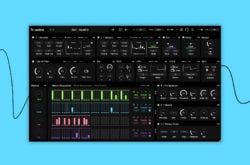You’ve probably heard of modular synths—those funny-looking devices with no keyboards in sight and a mess of cables hanging everywhere.
Maybe you can’t wrap your head around how you could ever play a melody on one of those machines, or maybe the art of the patch is like second nature to you. Hopefully, by the end of this article, you’ll feel at least a bit closer to the latter.
The principles of modular synthesis
The principles of synthesis are basically the same between modular and non-modular. In fact, a lot of software synthesizers, (Serum, Astra, and Massive, to name a few) are somewhat modular in their design.
That said, one of the core differences that makes modular so exciting is that you can pick and choose exactly which oscillator, effect, or other module will suit your needs, rather than being limited to the choices that a synth’s manufacturer made for you. You get to build your own unique synth from scratch, and the building blocks are nearly limitless. Some modular systems are specialized to perform live techno music, some are sound design powerhouses for studio use, and some are generative ambient machines that will perform new and unique melodies for hours if you let them. Your ideal rack might be a combination of all of those things—or it might be nothing like any of them.
Beyond module selection, modular synthesists have an added level of customization and control thanks to the way components must be patched together. Unlike most standalone synths with fixed signal chains, modules are not connected until you use patch cables to connect them exactly how you’d like. In doing so, you get to choose exactly which signals are sent to which inputs, making the world your oyster; the more complex a module is, the more endless its patching capabilities can be.
Even with just two interesting modules, you might be able to create dozens of different patches with unique sonic characteristics. I know that might seem a bit overwhelming at first, so let’s dive into the origins of all this and get some more context. The different ways that people have approached modular synthesis throughout its creation can help explain how it’s used in the present day, and can help you discover what you might want to do with it.
The history of modular synthesis
There are a few types of modular synths out there, designed with different philosophies and priorities in mind. Some of the first were built by Bob Moog on the east coast in the 1960s; they were pretty big, and used similarly large ¼” patch cables. Moog was very interested in creating approachable and performable devices for mainstream artists, so his devices were usually tailored for recreating acoustic sounds like brass and strings.
His synths first entered the public eye largely thanks to Wendy Carlos’ Switched-On Bach, a compilation of synthesized Bach compositions performed entirely with Moog’s devices. However, they remained popular across countless genres into the 1970s and ’80s, and they still hold a place in studios and stages all over the world today. Moog often added keyboards to these synths to make them more intuitive and easier to perform with, inventing what we now call the semi-modular synth. These semi-modular systems, like the Grandmother, are still some of their most popular; however, Moog has largely drifted from its modular origins, and plenty of their synths today are standalone devices with little to no modular compatibility.
Musicians continuing to pay homage to Wendy Carlos, Switched-On Bach, and Moog in 2020
Serge and Doepfer enter the scene
Other types of synths were created around this time too—for one, Serge Tcherepnin started his own line of Serge synths in the 1970s. They were the same size as Buchlas, and carried a similarly experimental approach. In fact, their timbre can be so experimental that they’ve even been used to imitate whale calls and communicate with deep sea life! What makes Serge synths so unique is that they don’t differentiate between audio signals and control voltage signals, encouraging new types of experimentation through audio-rate modulation. Despite their obscurity, some synthesists still swear by the versatility of Serge systems. They’re especially popular among people who build their own synths from scratch, as the blueprints are easy to find online and relatively accessible.
But everything changed when the Doepfer nation attacked. German manufacturer Doepfer started their own line of synth modules, the Eurorack, in the 1980s. The modules were smaller than all of their predecessors, and intended to be more customizable and accessible. It certainly hit the mark for accessibility; today, over 450 unique manufacturers have contributed to the plethora of Eurorack modules on the market, and more spring up every year. Some recent and popular companies making powerful modules include Mutable Instruments, MAKENOISE, Noise Engineering, and Instruo—the list could go on.
The impact of classic systems today
All of these systems still exist today, and they all have their own pros and cons when weighed against each other. Moog has changed their approach somewhat significantly; lots of their devices from recent years are smaller in size and use 3.5 mm patch cables for the sake of Eurorack compatibility.
Speaking of which, the Eurorack community has grown so immensely during its lifespan that it has become possible to achieve almost any goal a synthesist could have with Eurorack. Many Eurorack systems are capable of both Buchla-esque sonic experimentation and Moog-ishly faithful recreations of acoustic sounds, but that doesn’t mean Buchla and Moog systems don’t still have their own unique timbres to experiment with.
Additionally, plenty of modules exist that can convert Eurorack signals to Buchla and vice versa! In short, despite how broad these systems have become, there are still some clear differences in the approaches that people take to them, and it’s definitely worth learning techniques from each school of synthesis—they’ve each paved the way in their own right.
The depths of modulation
This article wouldn’t be about modular synthesis if we didn’t mention the (arguably) most important aspect of modular synthesis: modulation. Of course, modulation is a core aspect of almost every synthesizer, but the customizability of modular allows you to modulate things in very strange and atypical ways.
Most modulation sources are either LFOs (low-frequency oscillators) that repeat indefinitely, or envelope shapes that repeat when a trigger is received. That said, there are countless other ways of modulating things (FM synthesis, anyone?) that modular puts right in front of you, within arms reach.
Envelopes and LFOs are built into most synths, and often hardwired so that they’re stuck to certain parameters, like a filter envelope or a vibrato. But, thanks to the patching possibilities of modular, you can send these control signals to almost any parameter you’d like. You could send an envelope to the pitch of your oscillator to create laserlike percussion or kick drum sounds. You could send an LFO to the waveshaping or wavefolding input of your oscillator to create an ever-shifting timbre. You could even send a modulation source through a VCA to modulate your modulation!
The possibilities are truly endless. Usually, the most exciting sounds that modular can make will come from either modulating something that you wouldn’t typically modulate, or using a modulation source that you wouldn’t typically use—or both!
Modular synthesis in the DAW
Don’t fret if you’re still not sure whether modular is your cup of tea; these modulation principles can be practiced and applied to your workflow even if you don’t use modular synths. Most software synths have some LFOs and envelopes that you can map to different parameters (Serum’s popularity is largely thanks to its vast and exciting mapping options, and Vital is a similarly capable and much cheaper option, if you’re on a budget).
What’s more, plenty of DAWs have modulation sources of their own! Ableton Live 11, for example, has LFOs and envelope followers / generators in Max that you can map to any parameter on a stock instrument or effect (third-party Max developers have created some more exciting modulation sources as well, if you want something with a little more character than your basic LFO shapes).
And if your DAW doesn’t have built-in LFOs and envelopes, you could always create one manually by drawing in some automation and copy / pasting it repeatedly. Next time your track feels a little bit flat, a subtle, repeated modulation on a usually-overlooked parameter might just give things the life that they’re missing.
In summary
If you’re interested in diving deeper into modular synthesis, there are plenty of ways that you could get started. Knobs has a great video series about the benefits of using Eurorack; it’s incredibly entertaining to watch and it gives you a great idea of how genuinely unique modular can be. If you watch that series and decide hardware is the route you want to take, modulargrid.net is a great place to start visualizing your rack and exploring which modules you might want to invest in.
If hardware is a bit too much of a commitment for you, there are plenty of software synths you can get started with to test the water. VCV Rack is a great standalone program for Windows, Mac, and Linux that offers hundreds of software modules for free. In fact, some popular Eurorack manufacturers (namely Instruo and Befaco) even offer software versions of their modules for free in VCV rack so you can try them out before purchasing one.
If you’d prefer a plugin to use within your DAW, take a look into Native Instruments’ Reaktor or Softube Modular—they both offer plenty of unique modules with very diverse patching capabilities. Softube also partnered with Doepfer, so Softube Modular offers digital recreations of some of the first Eurorack modules to ever exist; if you’re a fan of analog emulation, this might be the modular software for you.
Alternatively, you can dive even deeper and choose a DAW intended for a modular workflow: Reason and Bitwig are both great options in this realm. Reason also offers plenty of its synths as VSTs if you’d like to try them out before committing to a new DAW.
At the end of the day, your options are really limitless. Take it slow and try not to get overwhelmed. Whether you’re starting with hardware or software, start small, with only a couple modules, and work your way up to complex patches one piece at a time. You can stumble upon a lot of really exciting techniques just by experimenting with the interactions of two simple modules and pushing them to their limits. Modular will teach you incredible things if you let go and see where it can take you; once you start to explore the furthest reaches of what your synths can do, you might catch yourself feeling inspired to try out some exciting, new techniques for even the simplest sounds.
Do you have any questions about modular synthesis? Let us know in the comments below.
Dive deeper into the world of synthesis with a free trial of Astra:
August 20, 2021



